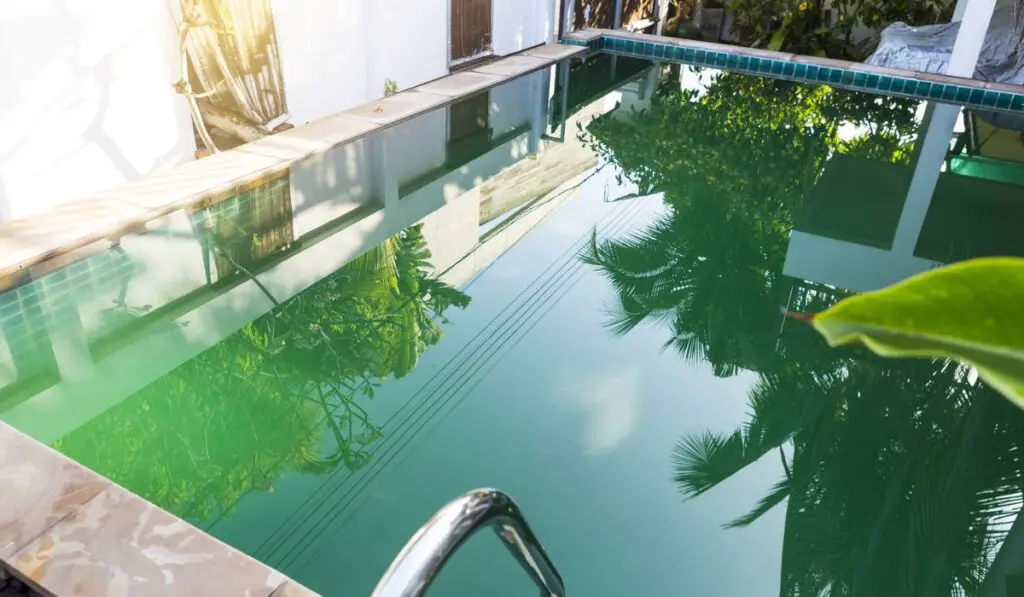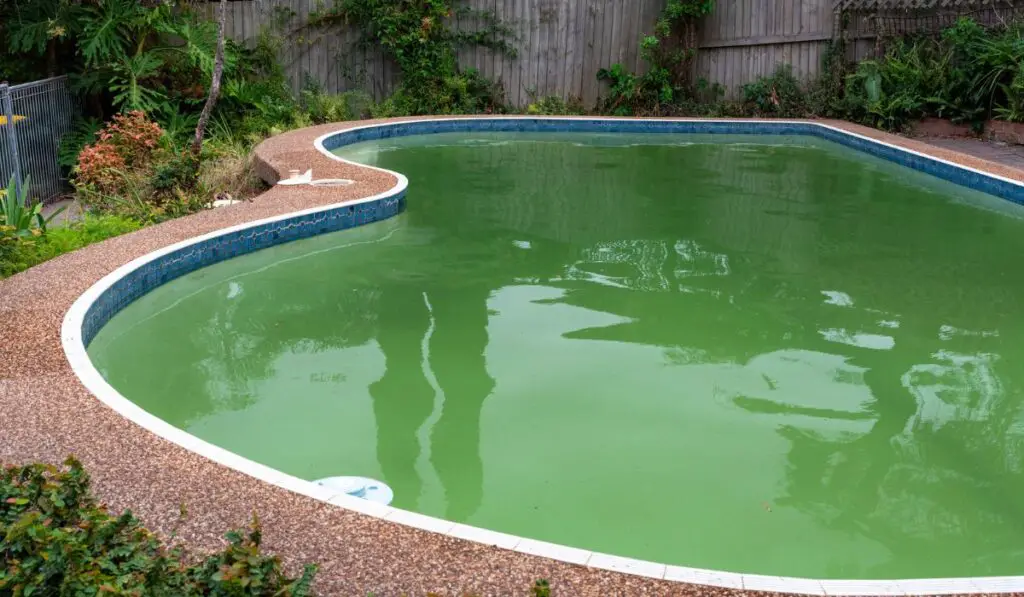The last thing you want to see as you’re heading for a refreshing dip in the pool is cloudy, green water. Sadly, you can’t just wave a magic wand and clear your pool overnight. If the water has turned into a bright shade of green, shocking your pool is the best way to get it back into shape. But what if the shock doesn’t seem to help?
Your pool may be green after shocking if the amount of shock wasn’t enough, or because it needs more time to work. Adding clarifier or flocculant, per the bottle’s instructions, will accelerate clearing of a green or cloudy pool. Expect to run the pump, turn it off to let dirt settle, then vacuum.
It’s important to note that clearing a green pool is a lengthy process and one that’s impossible to complete within 24 hours. However, having weekly or bi-weekly maintenance can help prevent a green pool in the first place. Let’s look at the reasons behind green pool water, how you can shock your pool, and what you should do if the water doesn’t clear even after shocking it.
Why Is Your Pool Green in the First Place?

Along with a chemical imbalance, there are several other reasons why your pool might be green. Some of the most common ones include:
Algae Overgrowth
Ensuring proper water circulation and achieving the right chemical balance can help prevent algae growth. However, if you don’t run your pool pump regularly or add the wrong chemicals, then your pool can become a breeding ground for algae and turn cloudy and green.
Although algae grow naturally in streams and ponds, an overgrowth in your swimming pool is a health hazard and a major cause for concern. Algae overgrowth can also lead to dangerous bacterial growth, so it’s best to avoid swimming in your pool until the water is crystal clear again.
Metals and Pollen
Along with pollen’s greenish-yellow shade, the oxidation of metal components in your pool itself (ladders and pump parts) can give the water a greenish tint. These metals might also react with the various chemicals in your pool, negatively affecting the delicate chemical balance of your pool.
You can easily reduce the amount of pollen in the water by using a high-quality pool cover (on Amazon) when your pool’s not in use. It’s also a good idea to hire a pool technician to check that all pool components are not deteriorating and are in overall good shape.
Low Free Chlorine Levels
The strong smell of chlorinated pool water can bring back childhood memories of fun, joy-filled summers. However, it’s important to note that well-balanced pools shouldn’t actually smell of chlorine.
Low free chlorine levels can lead to algae growth, resulting in green pool water. However, too much chlorine isn’t a good thing either. In fact, a high chlorine level can oxidize all the metal components in your pool, turning it into a different shade of green.
High pH Level
Your pool water should be reasonably neutral and have a pH level of somewhere between 7.3 and 7.6. If the pH level is too high (more than 7.8), the chlorine in your pool won’t be able to work effectively.
If your pool has a high pH level, try adding a pH reducer, like muriatic acid (on Amazon) or sodium bisulfate (also on Amazon), to bring it down to the right level.
How Much Shock Does It Take to Clear a Green Pool?
Shocking your pool water basically means over-chlorinating it. The process includes adding up to five times the normal amount of chlorine in your pool to kill the bacteria and algae turning your pool green.
You can determine the amount of pool shock (on Amazon) needed to clear a green pool by the color of the water itself. Keep in mind that one pound of shock is enough for up to 10,000 gallons of water.
Teal or Light Green Pool Water
This means that there’s not a lot of algae in your pool, so you’ll only have to use a bit of chlorine shock. In such cases, it’s best to double shock your pool water.
In order to double shock, you’ll need to add two pounds for every 10,000 gallons. For example, if your pool holds 20,000 gallons of water, you’ll need to add four gallons of shock.
Dark Green or Green Pool Water
Dark green pool water indicates a medium amount of algae, so it’s best to triple shock your swimming pool. That means that you’ll need to add three pounds of shock treatment for every 10,000 gallons. For instance, you’ll need to add six gallons of shock to a 20,000-gallon pool.
Black-Green Pool Water
This is the worst color to find, and you’ll need to quadruple shock the water. That means that you’ll need to add four pounds of shock for every 10,000 gallons (eight pounds for a 20,000-gallon pool). Keep in mind that this can be pretty costly if you have a large pool.
It’s important to note that shocking alone doesn’t clear up a cloudy or green pool. Instead, you’ll need to run your filter to fully treat the water. And if you have a bad filter, then no amount of shock will clean your pool.
How Long Does It Take a Green Pool to Clear Up After Being Treated?
You should see a transformation in your pool about 24 hours after treating it. Remember that the ultimate goal is to kill algae and turn your pool back to its sparkling blue color. It’s also important to run your filter and pump for at least 10 hours after the shock treatment (and during it).
Test your pool water 24 hours after shocking it and then adjust the alkalinity and pH levels accordingly. You’ll notice elevated chlorine levels at first, but they should start stabilizing after a few days.
You can lower the chlorine level by adding sodium thiosulfate, but that’s not advisable because adding too much can result in the chlorine level seesawing back and forth.
If you’ve followed all the right instructions, but your pool still isn’t clear after five days, then you might have a filter or pump problem.
What Should You Do if the Pool Is Still Green After Shocking?

If shocking your pool didn’t clear the water, there are a few other things you can try:
Brush Thoroughly
Just as using a toothbrush is important for healthy teeth, using a pool brush (on Amazon) is also important for a healthy pool.
From algae to pollen and leaves, the walls of your pool might have debris attached to them that’s making the water green. This debris will particularly be present in your pool’s dead spots where the water doesn’t quite circulate properly, leading to pollutant build-up.
Along with brushing regularly, it’s also important to choose the right brush for your specific swimming pool finish. Brushes with steel bristles are best for hard surfaces, such as concrete or plastic, while softer bristles are ideal for tile finishes.
Add Clarifier or Pool Flocculant
Pool clarifier (on Amazon) and pool flocculant (also on Amazon) are very similar chemicals that can help fix green pool water. Flocculant works by binding small particle impurities present in your pool, causing them to sink to the bottom of your pool.
A clarifier works exactly like a flocculant, with one small exception. Instead of sinking to the bottom, the clumps of particle impurities float on your pool’s surface, allowing you to remove them with a skimmer, or let your pool’s filter do its job.
Check Your Filter System
Proper water filtration and circulation help ensure a sparkling, clean pool. This is because both processes constantly mix sanitization chemicals, dispersing them throughout the pool.
If your filter isn’t cleaning your pool efficiently enough, then you may need to clean, backwash, or replace it.
Check Your Pool’s Chemistry
If you cleared your pool’s green water, but it turned green again, then there might be some problem with your pool’s water chemistry.
Testing the water regularly and adding the right amount of chemicals can help ensure the correct balance. Here are a few things you should keep an eye on:
pH Level
It’s imperative to have a properly balanced and neutral pH level in your pool. The recommended pH level ranges from 7.2 to 7.6, but it’s best to aim for 7.4.
If the pool water falls below 7.2, it turns too acidic, and if it rises above 7.6, it turns alkaline — both of which lead to changes in water color and more serious swimming pool issues.
Chlorine Level
It’s important to always have sanitizer in your pool, but too little or too much chlorine can turn the water green. Make sure your pool’s chlorine level is at least 1.0 ppm and at most 3.0 ppm.
Of course, shocking the pool will result in temporarily higher chlorine levels, so make sure you wait for the chlorine to level out before jumping into the pool again.
Cyanuric Acid
Also known as a pool stabilizer, cyanuric acid extends the lifespan of the chlorine in your pool and protects it from the sun’s harmful UV rays.
However, if there’s too much CYA in your pool, the chlorine molecules will “lock up” and become completely ineffective. It’s best to have a cyanuric acid level of 50 ppm. If it’s too high, then you’ll have to dilute the pool to bring it back down.
Total Alkalinity
Alkalinity is the amount of dissolved bicarbonates, carbonates, cyanurates, and hydroxides in your pool. The recommended level of total alkalinity ranges from 80 to 120 ppm.
If alkalinity falls below this range, you’ll have a green, acidic pool, while going above it will result in a cloudy, alkaline pool, which is a bit difficult to fix.
